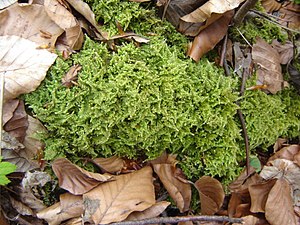Soft comb moss
| Soft comb moss | ||||||||||||
|---|---|---|---|---|---|---|---|---|---|---|---|---|

Soft comb moss ( Ctenidium molluscum ) |
||||||||||||
| Systematics | ||||||||||||
|
||||||||||||
| Scientific name | ||||||||||||
| Ctenidium molluscum | ||||||||||||
| ( Hedw. ) ( Chimp. ) |
The soft comb moss or ostrich feather moss ( Ctenidium molluscum ) is a species from the genus of the comb moss ( Ctenidium ). It used to be known by the synonym Brachythecium velutinoides . It was developed by the members of the Bryological-Lichenological Working Group for Central Europe e. V. (BLAM) elected Moss of the Year 2017.
Varieties
In addition to the main type, there are also varieties:
- Ctenidium molluscum var. Subplumiferum ( Kindb. ) Giac.
description
The leaves of the soft comb moss are dense and simply pinnate, which leads to a characteristic triangular shape of the individual fronds. The cell network of the leaves is prosenchymatic . The leaf color is strong green when wet, golden green to golden brown when dry, the moss forms dense lawns. The tips of the stem are mostly curved downwards in the shape of a hook. The leaves are strongly crescent-shaped bent downwards. The leaf margin is sawn along its entire length. The cells are papillary .
distribution
The species is distributed across the northern hemisphere . It loves lime and is widespread in limestone mountains, otherwise rather rare. It grows on earth as well as on rocks, rarely also on bark.
literature
- Carsten Schmidt: Bryological investigations of the mass limestone and Sparganophyllum limestone rocks of Westphalia (= Lynx. 2004, 2). Volume 1. Wolf & Kreuels, Havixbeck-Hohenholte 2004, ISBN 3-937455-04-3 .
Individual evidence
- ↑ Moss of the Year 2017 ( Memento of the original from October 14, 2016 in the Internet Archive ) Info: The archive link was inserted automatically and has not yet been checked. Please check the original and archive link according to the instructions and then remove this notice.
